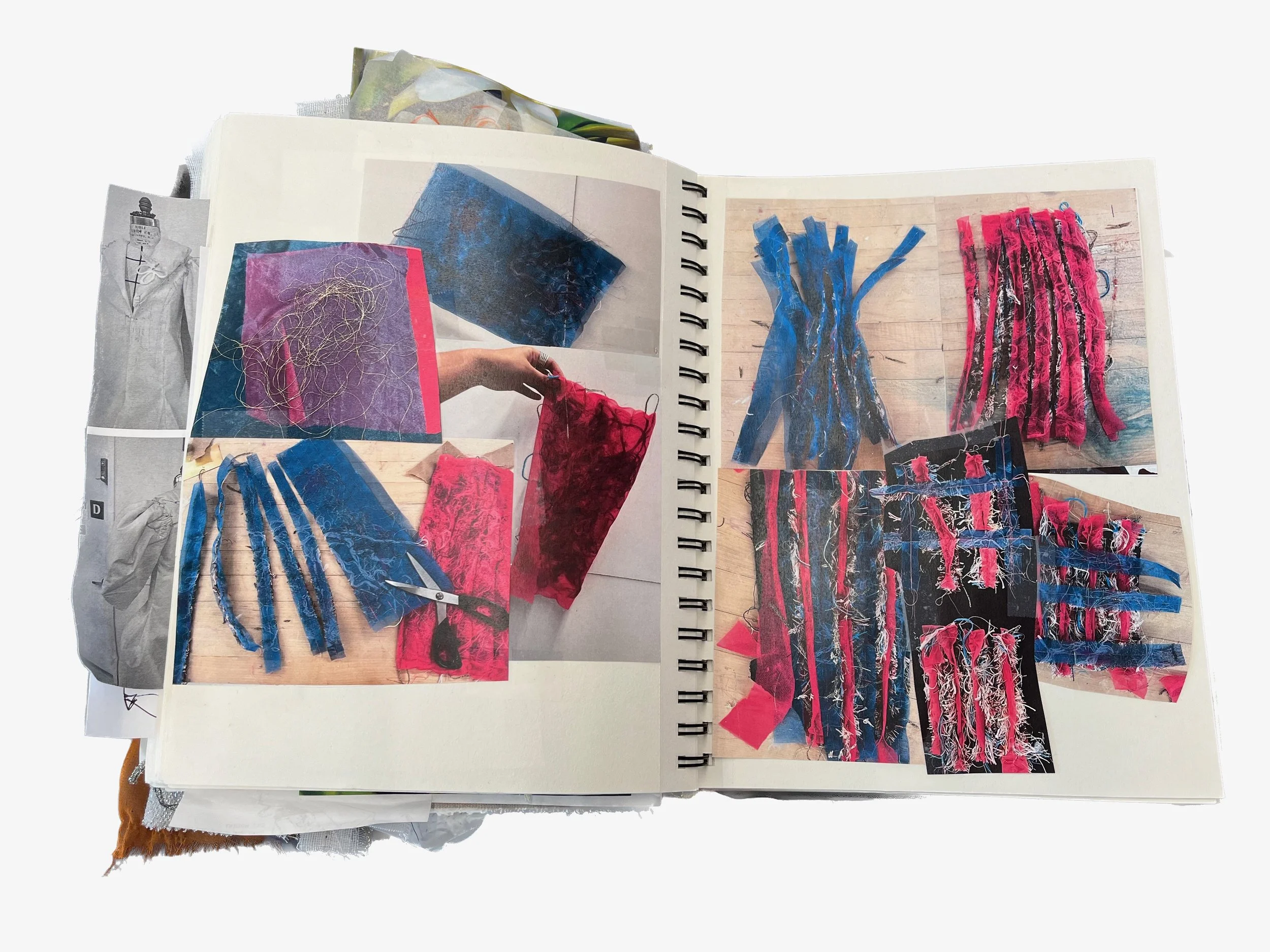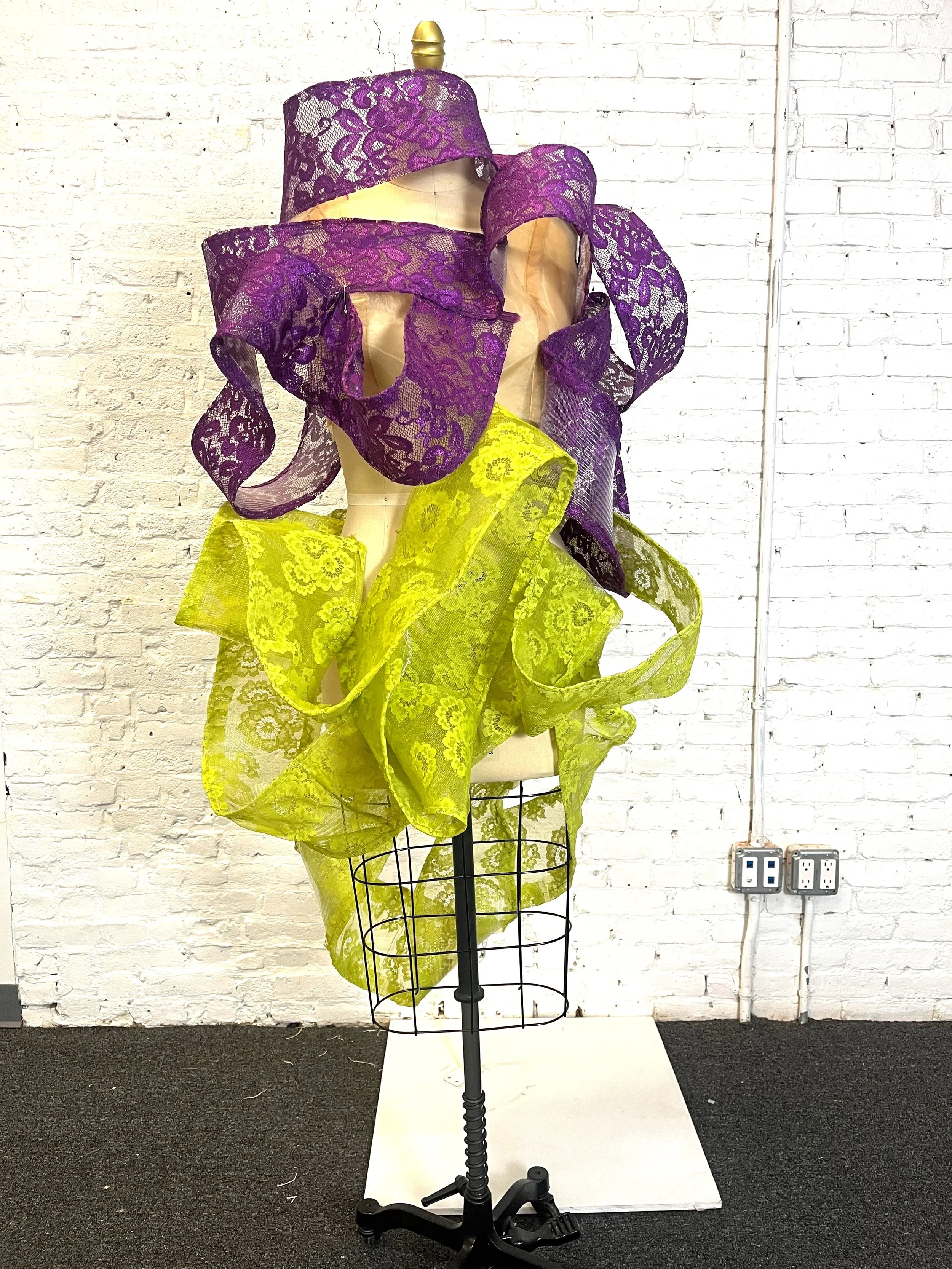Fresh Faces: Karina Nasywa Bakri
Indonesian traditional dress reimagined through deadstock fabric
F&M’s Fresh Faces is a series featuring young Southeast Asian fashion practitioners, where we speak with them about how they embarked on their careers and what propels them as creatives.
Xin Lee with TheKarina Nasywa Bakri. Photo by Zach Bergren. Arctic Fox Bonnet, commissioned in 2024. Photo by Xin Lee.
Karina Nasywa Bakri is a New York-based fashion designer who transforms deadstock fabrics into sculptural garments. Her late father, an architect, taught her to draw as a child, and those early sketches evolved into the philosophy of controlled chaos that now drives her whimsical, three-dimensional approach to design.
Karina holds a BA in Textile Design from Bandung Institute of Technology and an MFA in Fashion Design and Society from Parsons School of Design, where she honed her craft through internships at 3.1 Phillip Lim, Gabriela Hearst, Prabal Gurung and Proenza Schouler. She currently works as a technical designer at Zero + Maria Cornejo.
Deadstock fabrics became central to her practice in 2020, while completing her undergraduate thesis during the COVID-19 lockdown in Jakarta. This sustainable approach culminated in her graduate collection in New York, constructed primarily from reclaimed outdoor-gear fabrics and donated deadstock lace. The collection reimagines the kebaya, a traditional Indonesian blouse worn with sarong or batik, through exaggerated scale and sculptural volume. Chantilly lace forms cascading loops and organic folds that envelop the body, creating silhouettes both dreamlike and theatrical.
In this conversation, she reflects on her relationship with deadstock fabrics and reclaimed materials, the influence of her late father, and how these elements shape her contemporary design practice.
Hi, Karina! To start, could you talk about your background? What or who are the main influences your work draws upon?
I was born in Bandung, Indonesia, and eventually lived between Jakarta and Bandung during my school years. My ethnicity is Batak, Malay, and Chinese. I grew up observing how my parents and extended family dressed for weddings, Eids, or gatherings. There was a lot of colour blocking, mixed metals, beading, and embroidery. I wanted to be a musician, so I used to pay attention to what my favourite musicians were wearing. They were mostly 2000s Indonesian pop stars. I was deeply inspired by them. My father also introduced me to his favourite musicians, so I grew up listening to a lot of Queen, Michael Jackson, Whitney Houston, and The Beatles. He taught me how to draw, and I used to combine all the colours and textures from seeing these musicians dress and experiment freely with the sketches.
Fittings for SS26 ‘Over and Out’ collection. Photo by Karina Nasywa Bakri.
Since 2020, you've worked with reclaimed materials, deadstock, and post-production waste. What has your relationship with these materials revealed to you, and how has it shaped the way you approach making clothes?
The post-production materials I found taught me how much excess there is in the world, especially now that I see it in two different countries. When I started out working with these materials, I would ask questions about the colours not matching or the texture not fitting the look that I was going for. My textile background helps me reframe those doubts as creative challenges to manipulate what I have into what I want. It has become an important part of my process.
Backstage at SS26 ‘Over and Out’ NYFW. Photo by Madison Voelkel / BFA.com.
Colour seems to carry significant emotional and cultural weight in your collections, from your debut collection’s neon reds to the vibrant hues of 2000s Indonesian hiking magazines in your thesis work. How do you think about colour in your practice?
I love working with colours. I reference a lot of Indonesian textiles and old photographs. My mum wore a mint green kebaya, a traditional Indonesian blouse-dress, for her wedding, contrasting with the dark red and gold textiles that adorned the backdrop. I still find that incredibly chic. Putting colours and textures together invokes a certain memory or story that I am telling in my collections, without needing to say too much in words.
Materiality experimentation for ‘what do you miss most about home?’ collection. Photo by Karina Nasywa Bakri.
You presented ‘what do you miss most about home?’ at Helsinki Fashion Week 2024, a collection inspired by a 1945 New York Times article about a devastated village in Java. Could you tell us more about this collection and what it represents for you?
One of my favourite parts about returning to school was the access we had to certain publication archives, such as The New York Times. I chose the year 1945 and found the article. It was a couple of months after I moved to New York and my first time experiencing a full season of winter.
The collection was inspired by my grandmother’s handmade kebaya from the 1940s and winter advertisements. It was also accompanied by an interactive digital world to reflect the collection’s story. I speculated that the people of the village became refugees in a region with four seasons. How would they adapt to the conditions whilst carrying their heritage with them? The collection definitely mirrored my own experience at the time and challenged my ways of making as well. I was new to the city and had to find new places to source my materials, so I worked with Materials for the Arts, a New York City initiative that provides access to free materials for non-profits and schools.
SS26 ‘Over and Out’ at NYFW. Photo by Daniele Oberrauch / Gorunway.com.
S26 ‘Over and Out’ collection lookbook. Photo by Zach Bergren, makeup by Erika Guzman, produced by Mo Paquin.
Your MFA graduate collection, ‘Over and Out’, reimagines traditional Indonesian garments like the kebaya through Chantilly lace, translating delicate, fitted elements into sculptural forms with exaggerated proportions. How did this collection come together, and what aspects would you want people to notice or understand about it?
I wanted to create something in memory of my father, as he is the one who truly influenced how I create. I went through all of my childhood drawings, old diaries, and photographs, and remembered how I used to draw incomprehensible swirls over figures. About 75% of the materials for the collection came from the TAKIHYO FOR GOOD initiative by Takihyo Co. Japan, with additional deadstock lace donated by local New York fashion companies and Solstiss France.
I wanted the pieces to float over the body like they did in my drawings, which was a technical challenge using a delicate lace. The kebaya is usually fitted, and extending it as far off as possible was a play of contrast in shapes in addition to colour. What I want people to notice is that it is not just a reinterpretation of tradition, but a way of honouring my heritage by transforming it into something unexpected.
Lace materiality for SS26 ‘Over and Out’ collection. Photo by Karina Nasywa Bakri.
From your collaboration with Watublapi weavers in Flores, Indonesia, to showcasing more recently at New York Fashion Week, your work speaks to both local traditions and international fashion dialogues. What are your thoughts on the current state and future potential of Indonesian fashion, both locally and within the broader Southeast Asian and global contexts?
Whenever I see the work of my friends and former colleagues in Jakarta, I think it is very exciting! I am glad that through platforms such as Jakarta Fashion Week, independent designers are getting both the local and international spotlights. People are dressing boldly and unapologetically themselves, which I love to see. I hope to see more Southeast Asian creatives in the global scene, leading luxury fashion companies, and giving our spin on what collections from big names could look like.
You've mentioned wanting to eventually lead a global brand before launching your own label. Looking ahead, what themes or ideas are you eager to explore further in your work? What directions feel most compelling to you right now?
I see myself continuing to explore ways of storytelling and push textile innovation in future projects. I have exciting ideas for the next collection, which will include a lot of material experimentation before finalising the silhouettes. I am compelled to find the balance between telling personal stories whilst also pushing forward conversations around sustainability and what contemporary luxury can mean.
Follow Karina’s work on Instagram at @_karinasywa_, and on their website here.







